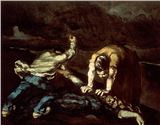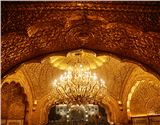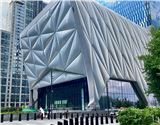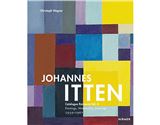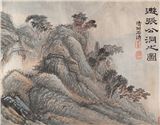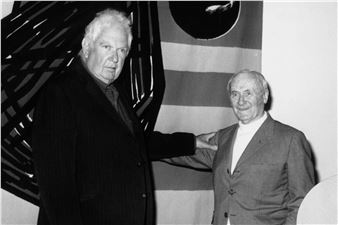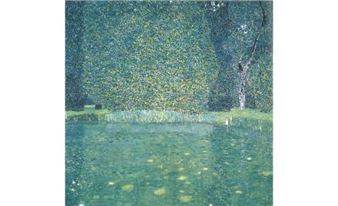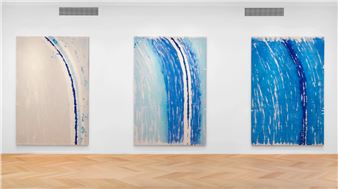Dario Escobar: Encrypted Messages
Almine Rech, New York (Upper East Side)
Upper East Side | New York | USAAlmine Rech New York is delighted to present the exhibition Encrypted Messages, of recent works by the Guatemalan artist Dario Escobar. Encrypted Messages is both the artist’s debut with the gallery and his first exhibition in New York since 2018.
Escobar’s art, which has been presented in international biennials and museums since the late 1990s, is rooted in his extended reflection on what it means to be an artist from Guatemala, a country that has enjoyed little tangible presence in earlier chapters of global art history. In his telling, Guatemalan art was last recognized during the Baroque period of Spanish colonization, and its emergence into the postmodern era has been fraught with cultural, economic and political inequities, traces of which invariably find their way into Escobar’s work. To address this imbalance, some of Escobar’s earliest works incorporated Baroque techniques, such as gold leaf and silver embossing, to transform commodity objects imported from China, which were then beginning to appear in Guatemala’s urban markets, into one-of-a-kind relics.
The origin of the Encrypted Messages series can be found in innumerable car trips that Escobar has made over the years through the countryside of eastern Guatemalan and southern Mexico, during which he would periodically stop to salvage discarded metal signs that had been used for target practice by persons, and for reasons, unknown. Originally emblazoned with advertisements for beverages or local businesses, or deployed simply as directional guideposts, once riddled with bullet holes the signs’ meanings were profoundly altered. Recognizing their potential, Escobar nonetheless opted to take his time in assimilating the transformation of meaning, explaining that “they represented things I did not understand.”
Not long ago, Escobar visited the Mexico City studio of the German-born Mexican artist Mathias Goeritz (1915-1990), where he gained fresh insight into the older artist’s use of gold foil on perforated metal surfaces to imbue his works with rhythmically coded messages that appear as constellations of small halos of light. Returning to the collected road signs altered by bullet holes, and to the technique of employing gold to highlight questions of value, Escobar decided to emphasize the signs’ indecipherability as the aspect he finds most compelling.
In the pivotal work Mensajes Cifrados N°21 [Encrypted Messages N°21], 2022, Escobar has stacked four of the signs vertically, their edges protruding directly from the wall so that both sides are visible to the viewer. The outer portions of the three larger signs has been leafed in gold, delineating the sectors containing the bullet holes. Likewise, throughout the series, Escobar uses gold to create designated spaces for the shot-up portions of the signs, treating them like religious icons. In Mensajes Cifrados N°24 [Encrypted Messages N°24], two differently sized and painted signs for a product called Boots are arranged vertically, with the top sign turned upside down to visually accommodate the vertical gold stripes highlighting where bullets pierced the metal.
Another historical connection this work invites us to consider is its formal relationship to pioneering experiments in geometric abstraction pursued by the Constructivist and Suprematist artists of the early 20th century. This is apparent with Mensajes Cifrados N°30 [Encrypted Messages N°30], in which roughly half the surfaces of four soft drink signs of the same size have been painted black, and arranged in spiral formation, with the product logos facing outward from the center. Escobar then painted gold bands along the edges of the signs and arranged them at the center of the configuration — a sly but hard-to-miss reference to works made in the 1920s by such canonic artists as Kasimir Malevich or Theo van Doesburg.
Like many other Latin American artists whose work became known internationally in the 1990s, Escobar has long felt a personal responsibility to address within his work the periodic spasms of political violence that have plagued recent Guatemalan efforts to establish a stable working democracy. But instead of making direct reference to events or causalities, the Mensajes Cifrados address the highly sensitive topic by returning to techniques and materials closely associated with the country’s colonial past, where the historical roots of political violence can be traced. With such references, Escobar invites us to view the final result not merely through the eyes of other cultural subjects, but also as a portal through which art made centuries ago is equally present. -Dan Cameron, Writer
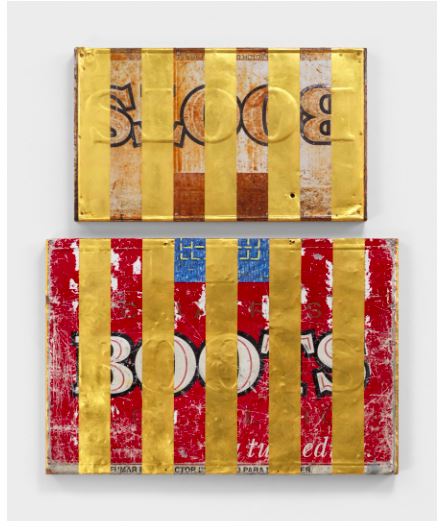
Almine Rech New York is delighted to present the exhibition Encrypted Messages, of recent works by the Guatemalan artist Dario Escobar. Encrypted Messages is both the artist’s debut with the gallery and his first exhibition in New York since 2018.
Escobar’s art, which has been presented in international biennials and museums since the late 1990s, is rooted in his extended reflection on what it means to be an artist from Guatemala, a country that has enjoyed little tangible presence in earlier chapters of global art history. In his telling, Guatemalan art was last recognized during the Baroque period of Spanish colonization, and its emergence into the postmodern era has been fraught with cultural, economic and political inequities, traces of which invariably find their way into Escobar’s work. To address this imbalance, some of Escobar’s earliest works incorporated Baroque techniques, such as gold leaf and silver embossing, to transform commodity objects imported from China, which were then beginning to appear in Guatemala’s urban markets, into one-of-a-kind relics.
The origin of the Encrypted Messages series can be found in innumerable car trips that Escobar has made over the years through the countryside of eastern Guatemalan and southern Mexico, during which he would periodically stop to salvage discarded metal signs that had been used for target practice by persons, and for reasons, unknown. Originally emblazoned with advertisements for beverages or local businesses, or deployed simply as directional guideposts, once riddled with bullet holes the signs’ meanings were profoundly altered. Recognizing their potential, Escobar nonetheless opted to take his time in assimilating the transformation of meaning, explaining that “they represented things I did not understand.”
Not long ago, Escobar visited the Mexico City studio of the German-born Mexican artist Mathias Goeritz (1915-1990), where he gained fresh insight into the older artist’s use of gold foil on perforated metal surfaces to imbue his works with rhythmically coded messages that appear as constellations of small halos of light. Returning to the collected road signs altered by bullet holes, and to the technique of employing gold to highlight questions of value, Escobar decided to emphasize the signs’ indecipherability as the aspect he finds most compelling.
In the pivotal work Mensajes Cifrados N°21 [Encrypted Messages N°21], 2022, Escobar has stacked four of the signs vertically, their edges protruding directly from the wall so that both sides are visible to the viewer. The outer portions of the three larger signs has been leafed in gold, delineating the sectors containing the bullet holes. Likewise, throughout the series, Escobar uses gold to create designated spaces for the shot-up portions of the signs, treating them like religious icons. In Mensajes Cifrados N°24 [Encrypted Messages N°24], two differently sized and painted signs for a product called Boots are arranged vertically, with the top sign turned upside down to visually accommodate the vertical gold stripes highlighting where bullets pierced the metal.
Another historical connection this work invites us to consider is its formal relationship to pioneering experiments in geometric abstraction pursued by the Constructivist and Suprematist artists of the early 20th century. This is apparent with Mensajes Cifrados N°30 [Encrypted Messages N°30], in which roughly half the surfaces of four soft drink signs of the same size have been painted black, and arranged in spiral formation, with the product logos facing outward from the center. Escobar then painted gold bands along the edges of the signs and arranged them at the center of the configuration — a sly but hard-to-miss reference to works made in the 1920s by such canonic artists as Kasimir Malevich or Theo van Doesburg.
Like many other Latin American artists whose work became known internationally in the 1990s, Escobar has long felt a personal responsibility to address within his work the periodic spasms of political violence that have plagued recent Guatemalan efforts to establish a stable working democracy. But instead of making direct reference to events or causalities, the Mensajes Cifrados address the highly sensitive topic by returning to techniques and materials closely associated with the country’s colonial past, where the historical roots of political violence can be traced. With such references, Escobar invites us to view the final result not merely through the eyes of other cultural subjects, but also as a portal through which art made centuries ago is equally present. -Dan Cameron, Writer
Artists on show
Contact details



